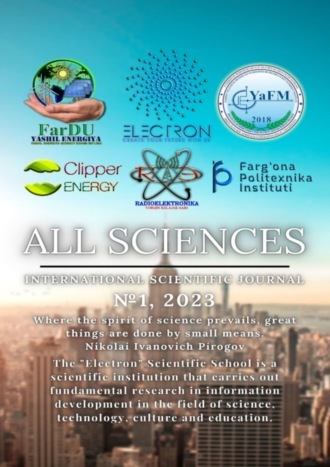
Полная версия
All sciences. №1, 2023. International Scientific Journal
It was then that this article caught the eye of the famous banker and industrialist John Pierpont Morgan, and he decided to meet with him, but he was only interested in using radio communication. So on January 11, 1900, Tesla returned to New York. The Tesla Tower is Nikola Tesla's first wireless telecommunications tower for commercial transatlantic telephony, radio broadcasting and demonstration of wireless power transmission. The first full-scale tests of the resonator tower took place on June 15, 1903 at exactly midnight local time. According to his plan, he wanted to create 5 towers for wireless communication around the globe, "as soon as the project is completed, a business person can dictate his instructions from New York, and they will immediately appear in the office in London or any other place. An inexpensive instrument, no more than a watch, will allow its owner to listen anywhere, at sea or on Land, to music or songs, speeches of a political leader, a speech by an outstanding scientist or sermons of a priest located at a great distance. In the same way, any picture, sign, drawing or text can be transmitted," Tesla said.
With the help of his project, he wants not only to transmit energy across the planet without wires, but with the help of this system, he intends to cause rains in the desert, illuminate the sky over sea routes, power cars and airplanes, and even carry out interplanetary communications. Of course, such a project required a much larger scope than Morgan singled out, but this does not bother him, and he creates on the island of Long Island, 60 meters from New York, he creates the first tower by the name of the Wardencliff locality. With the unfinished tower, he begins fantastic experiments. In the summer of 1903, the tower on Long Island almost drives New Yorkers crazy, giant artificial lightning bolts stretch for hundreds of miles in all directions from it. They light up the sky over the Atlantic so that you can read the newspaper headlines that the newspaper "New York San" writes: "Last night we witnessed strange phenomena – giant lightning, personally emitted by Tesla. The layers of the atmosphere ignited at different heights and over a large area so that the night instantly turned into day, the whole air was filled with glow. It centered around the edges of the human body, and everyone present radiated a light blue mystical flame. We felt like ghosts to ourselves." As Tesla himself wrote: "The waves created by my transmitter will be the greatest spontaneous manifestation of energy on the planet."
The halo surrounding Tesla's personality and discoveries contributed to the spread of all kinds of statements, which are usually semi-mythical in nature. Such statements cannot be verified due to the lack of documents, which does not prevent, however, attributing to Tesla a direct or indirect relation to many mysteries of the XX century.
According to legend, after Tesla's death, the FBI special department, which was engaged in storing the property of foreign citizens (Eng. Alien Property Custodian), sent employees who seized all the papers they found in the room. The FBI suspected that even a few years before Tesla's death, some papers had been stolen by German intelligence and could be used to create German flying saucers. Wanting to prevent a repeat of this incident, the FBI classified all the papers they found.
The book by writer Tim Schwartz mentions that in other hotels where Tesla rented rooms, his personal belongings also remained. Some of them are lost, more than 12 boxes of things were sold to pay Tesla's bills. Tim Schwartz also claims that in 1976, four nondescript boxes of papers were auctioned by a certain Michael P. Bornes, a bookseller from Manhattan. Dale Alfrey bought them for $25, not knowing what kind of papers they were. According to the author of the book, it later turned out that these were Nikola Tesla's laboratory journals and papers, which described hostile alien creatures capable of controlling the human brain.
Many readers have questioned Tim Schwartz's claims, perceiving the book as an attempt to create a sensation. It is hardly possible to talk about Tesla's direct participation in the hypothetical event of the "Philodelfi experiment" due to the discrepancy between the dates of Tesla's life and the time of the alleged experiment, since Tesla himself died before it began – on January 7, 1943, while it is assumed that the experiment was conducted only on October 28, 1943.
In 1931, Nikola Tesla allegedly demonstrated a working prototype of an electric car moving without any traditional current sources. There is no material evidence of the existence of this electric car.
The American agency DARPA in 1958 allegedly tried to create Tesla's legendary "death rays" during the Seesaw project, which was conducted at the Livermore National Laboratory. In 1982, the project was interrupted due to a number of failures and budget overruns.
At the end of the XX – beginning of the XXI century, a hypothesis appeared about the connection of Nikola Tesla with the Tunguska meteorite. According to this hypothesis, on the day of the observation of the Tunguska phenomenon (June 30, 1908), Nikola Tesla conducted an experiment on the transmission of energy «through the air». A few months before the explosion, Tesla claimed that he would be able to light the way to the North Pole of the expedition of the famous traveler Robert Peary. In addition, there are records in the journal of the Library of Congress that he requested maps of «the least populated parts of Siberia.» His experiments on the creation of standing waves, when, as it is claimed, a powerful electric pulse was concentrated tens of thousands of kilometers away in the Indian Ocean, quite fit into this «hypothesis». If Tesla managed to pump an impulse with the energy of the so-called «ether» (a hypothetical medium, to which, according to scientific ideas of the past centuries, the role of a carrier of electromagnetic interactions was attributed) and the resonance effect to «rock» the wave, then, according to this assumption, a discharge with a power comparable to a nuclear explosion should have occurred.
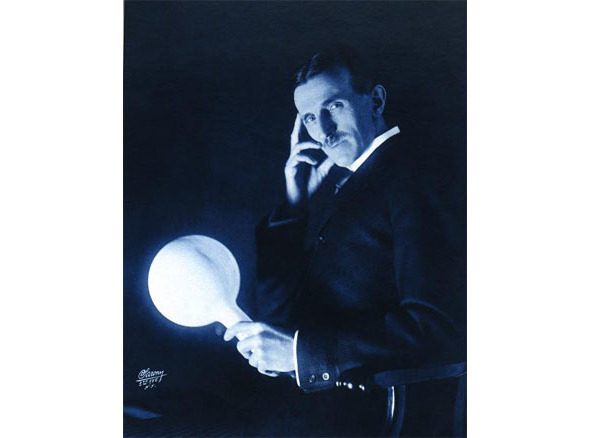
Tesla with a burning gas discharge lamp demonstrates wireless transmission of electricity
In total, Tesla has more than 700 inventions and patents, some of which are the most important historical milestones of modern electricity. Tesla probably invented radio before Marconi and Popov, and also worked with X-rays before their official discovery by Wilhelm Roentgen.
Working for Westinghouse, he patented the use of multiphase alternating current systems. Before the invention of the asynchronous (induction) motor, alternating current was not widely used, since it could not be used in pre-existing electric motors. Since 1889, Nikola Tesla began to study high-frequency currents and high voltages. He invented the first samples of electromechanical HF generators (including inductor type) and a high—frequency transformer (Tesla transformer, 1891), thereby creating prerequisites for the development of a new branch of electrical engineering – HF technology.
In the course of research on high-frequency currents, Tesla also paid attention to safety issues. Experimenting on his body, he studied the effect of alternating currents of various frequencies and strengths on the human body. Many of the rules first developed by Tesla have become part of the modern fundamentals of safety when working with RF currents. He found that at a current frequency of over 700 Hz, an electric current flows over the surface of the body without harming the tissues of the body. Electrical devices developed by Tesla for medical research have become widespread in the world.
Experiments with high-frequency high-voltage currents led the inventor to discover a method for cleaning contaminated surfaces. A similar effect of currents on the skin showed that in this way it is possible to remove small rashes, clean pores and kill germs. This method is used in modern electrotherapy.
On October 12, 1887, Tesla gave a rigorous scientific description of the essence of the phenomenon of a rotating magnetic field. On May 1, 1888, Tesla received his main patents for the invention of multiphase electric machines (including an asynchronous electric motor) and a system for transmitting electricity by means of a multiphase alternating current. Using a two-phase system, which he considered the most economical, a number of industrial electrical installations were put into operation in the USA, including the Niagara Hydroelectric Power Station (1895), the largest in those years.
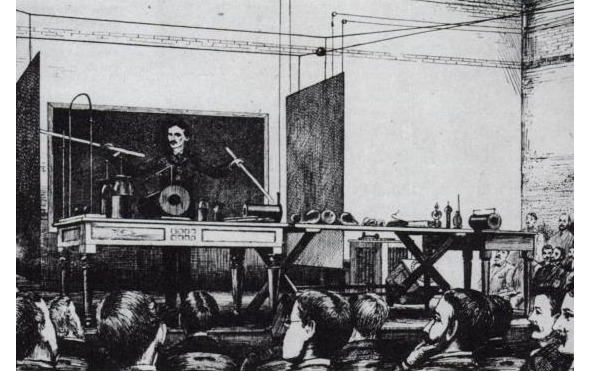
Tesla demonstrates the principles of radio communication, 1891
In 1891, at a public lecture, Tesla described and demonstrated the principles of radio communication. Tesla was one of the first to patent a method for reliably obtaining currents that can be used in radio communications. U.S. Patent 447,920, issued in the United States on March 10, 1891, described the "Method of Operating Arc Lamps" ("Method of Operating Arc-Lamps"), in which an alternating current generator produced high-frequency (by the standards of that time) current fluctuations of the order of 10,000 Hz. A patented innovation was the method of suppressing the sound produced by an arc lamp under the influence of alternating or pulsating current, for which Tesla came up with the idea of using frequencies that are beyond the perception of human hearing. According to the modern classification, the alternator operated in the range of very low radio frequencies.
In 1893, the scientist took up the issues of wireless communication and invented a mast antenna.
Nikola Tesla Awards:
1. Knight of the Montenegrin Order of Prince Danilo I, 2nd degree (1895).
2. Knight of the Grand Cross of the Order of the White Lion (Czechoslovakia) (1891),
3. Elliot Cresson Medal (1894),
4. Edison Medal (AIEE, 1916),
5. John Scott Medal (1934)
Tesla's name is very popular today. The unit of measurement of magnetic induction in the international system of SI units is named after Tesla. The airport in the Belgrade suburb of Surcin is named after Nikola Tesla. In Croatia, in the resort town of Porec (horv. Poreč), located on the western coast of the Istrian peninsula, there is an embankment named after Nikola Tesla. Streets in Zagreb, Sibenik, Split, Rijeka, Varazdin, Budva (Montenegro), Moscow (IC "Skolkovo"), Yekaterinburg, Teremakh, Lozhka, Astana, Minsk are named after Tesla. Monuments to Tesla are installed near the University of Belgrade, Belgrade International Airport, the Church of the Resurrection of Christ in Podgorica, as well as in the cities of New York (USA), Niagara Falls (USA), Prague (Czech Republic), Cheboksary (Russia), the capital of Azerbaijan – Baku. In Cheboksary, on Ivan Yakovlev Avenue, there is a square named after N. Tesla. There is also the only monument to the inventor in Russia.
In 1970, the International Astronomical Union named a crater on the far side of the moon after Tesla. The asteroid (2244) is named after him Tesla. Thanks to a grant allocated by 2020 ($750,000), the Tesla Research Center in Wardencliff (New York, USA) will turn one laboratory into a museum of Tesla and his legacy, as well as an educational and research center; at the same time, a corresponding program in the field of entrepreneurship and technology will be created.
In the fall of 1937, in New York, 81-year-old Tesla left the New Yorker Hotel to feed the pigeons at the cathedral and library, as usual. Crossing the street a couple of blocks from the hotel, Tesla could not dodge a moving taxi and fell, suffering a back injury and a fracture of three ribs. Tesla refused the services of a doctor, which he followed before, and never fully recovered. The incident caused acute pneumonia, which turned into a chronic form. Tesla was bedridden for several months and was able to get up again in early 1938.
A war has begun in Europe. Tesla was deeply worried about his homeland, which was under occupation, repeatedly making fervent appeals for peace to all Slavs (in 1943, after his death, the first Guards Division of the People's Liberation Army of Yugoslavia was named Nikola Tesla for his courage and heroism). On January 1, 1943, Eleanor Roosevelt, the wife of the US president, expressed a wish to visit a sick Tesla. Tesla's nephew Sava Kosanovich visited him on January 5 and arranged a meeting. He was the last person to communicate with Tesla.
Nikola Tesla died in his New Yorker Hotel room on the night of January 7-8, 1943, at the 87th year of his life. The body was discovered on January 8 by the maid Alice Monahan, who entered the room despite the "do not disturb" sign posted by Tesla on January 5. According to the coroner's report, death occurred around 22:30 at night, presumably from coronary thrombosis. On January 12, the body was cremated, and the urn with the ashes was installed at Ferncliffe Cemetery in New York. In 1957, it was moved to the Nikola Tesla Museum in Belgrade.
Aliyev I. X.CEO of OOO «Electron Laboratory»,President of the Electron Scientific SchoolPHYSICAL AND MATHEMATICAL SCIENCES
CO2 GAS CONCENTRATION MONITORING DEVICE
UDC 620.191
Qo’ldashov Obbozjon Xakimovich
Doctor of Technical Sciences, Professor of the Scientific Research Institute "Physics of Semiconductors and Microelectronics" at the National University of Uzbekistan
Bekchanov Ulug’bek Qo’ziboy o’g’li
2nd year Master of the Department of "Physics of Semiconductors and Polymers" of the Faculty of Physics of the Mirzo Ulugbek National University of Uzbekistan
Scientific Research Institute «Physics of Semiconductors and Microelectronics» at the National University of Uzbekistan
Annotation. The article discusses the principles of constructing an optoelectronic device for monitoring the concentration of CO2 gases. Intense absorption lines of CO2 gases have been determined. The optoelectronic device uses LEDs based on GaAlAsSb/GaInAsSb/GaAlAsSb (3.12 microns) as the emitting diode at the reference wavelength, and LEDs based on GaAlAsSb/GaInAsSb/GaAlAsSb (3.39 microns) as the emitting diode at the measuring wavelength.
Keywords: gas analyzer, carbon dioxide, control, flowchart, time diagrams.
Аннотация. В статье рассматриваются принципы построения оптоэлектронного устройства для контроля концентрации CO2 газов. Определены интенсивные линии поглощения CO2 газов. В оптоэлектронном устройстве использованы в качестве излучающего диода на опорной длине волне светодиоды на основе GaAlAsSb/GaInAsSb/ GaAlAsSb (3.12 мкм), а излучающего диода на измерительной длине волны светодиоды на основе GaAlAsSb/GaInAsSb/GaAlAsSb (3.39 мкм).
Ключевые слова: газоанализатор, углекислые газы, контроль, блок схема, временные диаграммы.
In recent years, more and more attention has been attracted to the problems of using clean unconventional renewable energy sources (NVE) for the needs of energy supply to various agricultural and industrial facilities. The relevance and prospects of this energy sector are due to two main factors: the catastrophically difficult situation of the environment and the need to search for new types of energy.
The successes achieved in the creation of wind, solar and a number of other types of unconventional power plants are widely covered in various works, recently much attention has been paid to geothermal energy. The prospects for using the Earth's heat energy are truly limitless, because under the surface of our planet, which is a giant natural energy boiler, huge reserves of heat and energy are concentrated.
Today, geothermal energy is actively developing in Uzbekistan. On the territory of Uzbekistan, forecast geothermal resources at accessible depths (up to 5-6 km) are 4-6 times higher than hydrocarbon resources. The main consumers of geothermal resources in the near and long term in Uzbekistan will undoubtedly be heat supply and, to a much lesser extent, electricity generation.
By absolute value, of all types of renewable energy, the subsoil of Uzbekistan has the greatest integral energy potential in the form of heat from dry rocks (petrothermal resources) and large basins with hydrothermal waters.
Geothermal waters are available in all regions of Uzbekistan. Long-term surveys have allowed to identify 8 large basins with hydrothermal resources on its territory. The gross potential of geothermal waters is estimated at 171 thousand tons. However, the technical potential of geothermal sources has not yet been determined. The Fergana Valley and Bukhara Viloyat have the greatest potential of geothermal waters. The average temperature of geothermal waters in the republic is 45.5 °C, the warmest waters are in Bukhara (56 °C) and Syrdarya (50 °C) viloyats. It should be noted that the practical realization of the energy of geothermal waters is associated with the development of appropriate environmental measures due to their chemical composition. Petrothermal energy resources in the form of dry rocks with temperatures from 45 to 300 °C have also been identified in the country. The realization of the potential of petrothermal energy (heat of dry rocks, granitoids) can be carried out using power plants on low-boiling working bodies with a block capacity of 40 MW on the basis of the Chust-Adrasman petrothermal anomaly in the Fergana Valley [1].
The main advantage of geothermal energy is its practical inexhaustibility and complete independence from environmental conditions, time of day and year [2-3]. Geothermal energy owes its "design" to the red-hot central core of the Earth, with a huge supply of thermal energy. Only in the upper three-kilometer layer of the Earth is stored the amount of thermal energy equivalent to the energy of about 300 billion tons of coal [4].
Figure 1 shows a diagram of the use of geothermal resources.
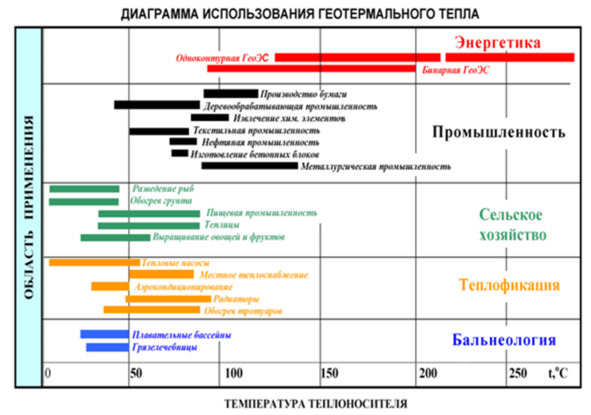
Fig.1. Diagram of the use of geothermal resources
Geothermal energy is widely and successfully used in various sectors of the national economy. There are very broad prospects for expanding the scope of its application:
– heat supply (heating and hot water supply) of civil and industrial buildings and structures;
– heat supply of agricultural facilities (greenhouses and greenhouses of both year—round and seasonal duration, fish-breeding ponds, poultry farms, etc.);
– satisfaction of technological processes of industrial enterprises in heat (drying of wood for furniture production, fermentation of tea leaves, etc.);
– satisfaction of the communal needs of the population (baths, swimming pools, laundries, etc.);
– balneological purposes; electricity generation.
Geothermal resources have several components: they can be considered simultaneously as a source of electrical and thermal energy and as a source of valuable chemical compounds: amorphous silica, B, Li, Zn, Mn, HS, NaCl, geothermal gases H2S, CO2.
Data on the chemical composition of geothermal resources show the presence of geothermal gases (H2S, CO2) in them [4], the control of the concentration of which greatly facilitates their development and the search for new sources of mineral raw materials.
As is known, there are intense absorption lines of geothermal CO2 gases in the range of 1.7—4.8 microns. The development of optoelectronics and its element base, the creation of new highly efficient semiconductor radiation sources create prerequisites for the development of highly sensitive and accurate, reliable devices for monitoring the concentration of geothermal gases (H2S, CO2).
In this paper, a device for monitoring the concentration of geothermal gases is proposed.
The block diagram of an optoelectronic device for monitoring the concentration of geothermal gases is shown in Fig.1, and its time diagrams are shown in Fig.2.
The device for monitoring geothermal gases contains a power source 1, a rectangular pulse generator with two antiphase outputs 2, to one output of which a frequency divider 3 (serial counter) is connected, the output of which is connected via a single-vibrator 4 to the control input of the exponent modulator 5, an emitter repeater 6, two electronic keys 7 and 8, emitting diodes working 9 and the reference 10, emitting at the reference and working wavelengths, respectively, a gas chamber 11, a photodetector 12 connected to the first differentiating device 13, the output of which is through the threshold input of the coincidence circuit 15, the first input of which is connected to the output of the second differentiating device 16, the input of which is connected to the emitting diode 10, the counter 17, the counting input of which is connected to the output of the coincidence circuit 15, and its input "zero setting" is connected to the output of the single-vibrator 4.
The gas chamber 11 is irradiated with two radiation streams F0l1 and F0l2 at the reference l1 and working l2 wavelengths, respectively. The radiation fluxes that have passed through the gas chamber will be equal, respectively:
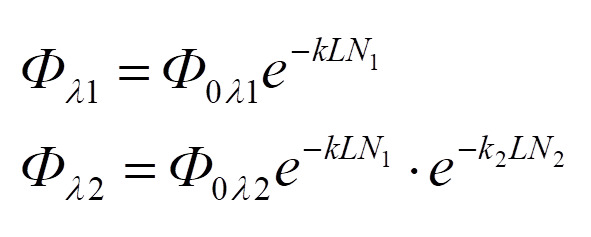
(1)
where: F0l1 and F0l1 are radiation fluxes feeding to the gas chamber at wavelengths l1 and l1, respectively, Fl1, Fl2 are radiation fluxes after passing through after passing through the gas chamber at wavelengths l1 and l2, respectively,
N1 – concentration of a mixture of gaseous substances,
L is the length of the optical path, i.e. the length of the gas chamber,
N2 is the concentration of the gaseous substance to be determined,
K1 is the scattering coefficient of a mixture of gaseous substances,
K2 is the absorption coefficient of the determined gaseous substances.
The flow of F0l1 changes in time (t) according to the exponential law
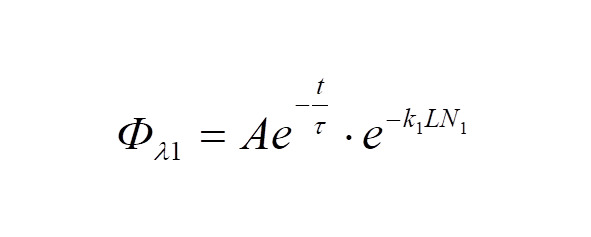
(2)
where A is a constant coefficient corresponding to the initial value of the exponential pulse amplitude.
At the moment of equality of flows Al1 and Al2
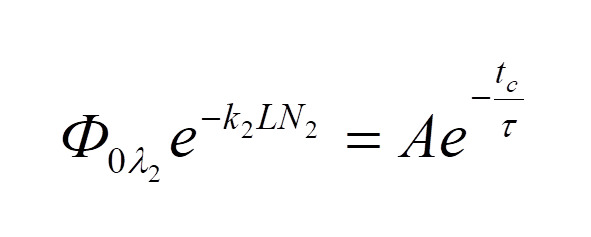
(3)
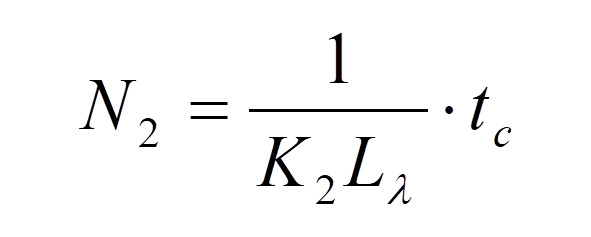
(4)
where tc is the time corresponding to the moment of comparison,
t is the time constant of the exponent.
The generator of 2 rectangular pulses generates pulses with the required repetition rate. These pulses from the antiphase outputs go to the input of the frequency divider 3 and to the control inputs of the keys 7 and 8. Rectangular pulses from the output of the frequency divider 3 (Fig.2.a) go to the input of one vibrator 4.
Rectangular pulses with the required duration from the output of one exponent vibrator 5, the output of which is connected via an emitter repeater 6 to the output of an electronic key 8, where a discrete exponential current pulse is formed, which flows through the emitting diode 9, causes a flux emitting according to the same law. The electronic key 7 switches counterphase to the pulses filling the exponent. The current pulse flowing through the emitting diode 10 causes a luminous flux, the amplitude of which is constant. The flows passing through the gas chamber are perceived by the photodetector 12.
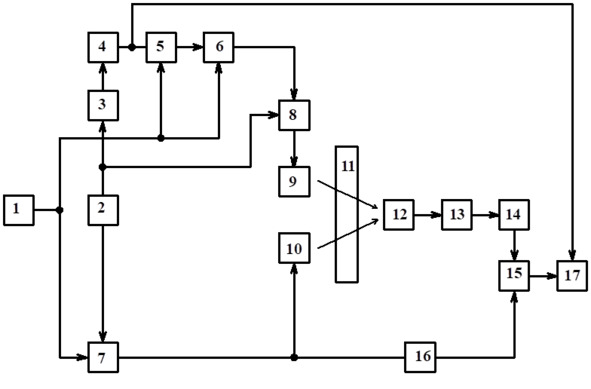
Fig.2. Block diagram of the device
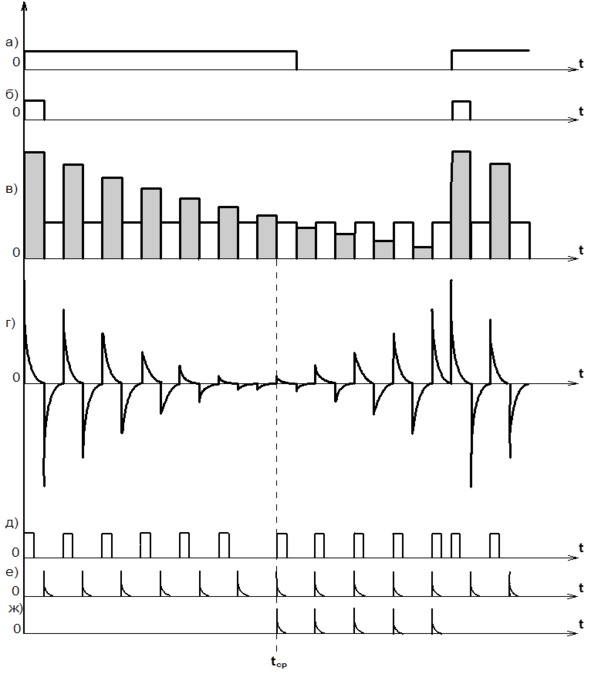
Fig.3. Time diagrams explaining the operation of the device.
(Fig.2.c) shows a time diagram of the total photoelectric signal at the output of the photodetector 12. This signal is fed to the input of the first differentiating device 13, from the output of which the differentiated photoelectric signal (Fig.2.d) enters the input of the threshold device 14.


